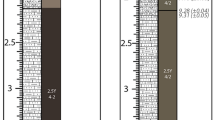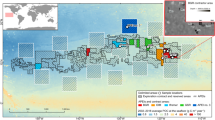Abstract
A Mid-Pliocene sequence in the sedimentary fill of the Val d’Orcia Basin (Tuscany, Italy) records coeval accumulation of temperate carbonate and siliciclastic deposits in close proximity. This study investigates the role played by local parameters in influencing the spatially discontinuous onset of carbonate sedimentation. Carbonate facies developed during transgression of an irregular coastline and were restricted to the more enclosed portion of an embayment. Coralline red algae were the main carbonate producers and are preserved in the skeletal association as isolated branches, rhodoliths, and incipient bindstone. When comparing the sedimentological attributes of the siliciclastic- and carbonate-dominated deposits, no significant differences are observed. They both appear to have accumulated in shallow-marine areas, subjected to general low-energy conditions punctuated by sporadic higher-energy events. Nevertheless, coastal morphology and bedrock composition at the basin margin created local heterogeneities that were sufficient to induce restricted spatial distribution of the carbonate-producing factory.










Similar content being viewed by others
References
Ambrosetti P, Carboni MG, Conti MA, Costantini A, Esu D, Gandin A, Girotti O, Lazzaretto A, Mozzanti R, Nicosia U, Parisi G, Sandrelli F (1978) Evoluzione paleogeografica e tettonica nei bacini tosco-umbro-laziali nel Pliocene e nel Pleistocene inferiore. Mem Soc Geol It 36:201–214
Basso D (1994) Study of living calcareous algae by a paleontological approach: the non-geniculate Corallinaceae (Rhodophyta) of the soft bottoms of the Tyrrhenian Sea (western Mediteranean). The genera Phymatolithon Foslie and Mesophyllum Lemoine. Riv It Paleont Strat 100:575–596
Basso D (1998) Deep rhodolith distribution in the Pontian Islands, Italy: a model for the paleoecology of a temperate sea. Palaeogeogr Palaeoclimatol Palaeoecol 137:173–187
Basso D, Fravega P, Piazza M, Vannucci G (1998) Biostratigraphic, paleobiogeographic and paleoecological implications in the taxonomic review of Corallinaceae. Rend Fis Acc Lincei 9:201–211
Basso D, Nalin R, Massari F (2007) Genesis and composition of the Pleistocene Coralligène de plateau of the Cutro Terrace (Calabria, southern Italy). N Jb Geol Paläont Abh 244(2):173–182
Bernini M, Boccaletti M, Moratti G, Papani G, Sani F, Dorelli L (1990) Episodi compressivi neogenico-quaternari nell’area estensionale tirrenica nord-orientale. Dati in mare e a terra. Mem Soc Geol It 45:577–589
Bettelli G, Conti S, Panini F Vannucchi P (2001) Depositi caotici nella successione pliocenica del bacino di Radicofani (Toscana meridionale): relazioni con la tettonica estensionale. In: Brogi A, Ghinassi M, Lazzarotto A, Lotta D (eds) Studi per l’interpretazione del profilo sismico CROP18. Siena, pp 49–57
Boccaletti M, Sani F (1998) Cover thrust reactivations related to internal basement involvement during Neogene-Quaternary evolution of the Northern Apennines. Tectonics 17:112–130
Bonini M, Sani F (2002) Extension and compression in the Northern Apennines (Italy) hinterland: evidence from the Late Miocene-Pliocene Siena-Radicofani Basin and relations with basement structures. Tectonics 21:1–35
Bossio A, Costantini A, Lazzarotto A, Lotta D, Mazzanti R, Mazzei R, Salvadorini G, Sandrelli F (1993) Rassegna delle conoscenze sulla stratigrafia del neoautoctono toscano. Mem Soc Geol It 49:17–98
Braga JC, Martín JM, Betzler C, Aguirre J (2006) Models of temperate carbonate deposition in Neogene basins in SE Spain: a synthesis. In: Carannante G, Pedley HM (eds) Cool-water carbonates: depositional systems and paleoenvironmental controls. Geol Soc Lond Spec Publ 255, pp 121–135
Bressan G, Babbini L (2003) Biodiversità marina delle coste italiane: corallinales del Mar Mediterraneo: guida alla determinazione. Biol Mar Medit 10(Suppl. 2):1–237
Cabioch J (1969) Persistance de stades juvéniles et possibilité d’une néoténie chez Lithophyllum incrustans Philippi. Compt Rend Hebd Séances Acad Sci Sér D 268:497–500
Cabioch J, Mendoza ML (1998) Mesophyllum alternans (Foslie) comb. nov. (Corallinales, Rhodophyta), a mediterraneo-atlantic species, and new considerations on the Lithothamnion philippii Foslie complex. Phycologia 37:208–221
Capozzi R, Picotti V (2003) Pliocene sequence stratigraphy, climatic trends and sapropel formation in the Northern Apennines (Italy). Palaeogeograph Palaeoclimatol Palaeoecol 190:349–371
Carannante G, Pedley HM (eds) (2006) Cool-water carbonates: depositional systems and paleoenvironmental controls. Geol Soc Lond Spec Publ 255
Carannante G, Esteban M, Milliman JD, Simone L (1988) Carbonate lithofacies as paleolatitude indicators: problems and limitations. Sediment Geol 60:333–346
Carey JS, Moslow TF, Vaughn Barrie J (1995) Origin and distribution of Holocene temperate carbonates, Hecate Strait, Western Canada continental shelf. J Sed Res 65:184–194
Carmignani L, Lazzarotto A (2004) Carta Geologica della Toscana: Litografia Artistica Cartografica Srl, Firenze
Carmignani L, Decandia FA, Disperati L, Fantozzi PL, Kligfield R, Lazzarotto A, Liotta A, Meccheri M (2001) Inner Northern Apennines. In: Vai GB, Martini IP (eds) Anatomy of an orogen. The Apennines and adjacent Mediterranean Basins. Kluwer, Dordrecht, pp 197–214
Cheel RJ, Leckie DA (1992) Coarse-grained storm beds of the upper Cretaceous Chungo Member (Wapiabi Formation), Southern Alberta, Canada. J Sediment Petrol 62:933–945
Clifton HE (2007) A reexamination of facies models for clastic shorelines. In: Posamentier HW, Walker RG (eds) Facies models revisited. SEPM Spec Publ 84, pp 293–337
Clifton HE, Dingler JR (1984) Wave-formed structures and paleoenvironmental reconstruction. Marine Geol 60:165–198
de Raaf JFM, Boersma JR, Gelder A (1977) Wave-generated structures and sequences from a shallow marine succession, lower carboniferous, County Cork, Ireland. Sedimentology 24:451–483
DeCelles PG, Cavazza W (1992) Constraints on the formation of Pliocene hummocky cross-stratification in Calabria (southern Italy) from consideration of hydraulic and dispersive equivalence, grain-flow theory and suspended-load fallout rate. J Sediment Petrol 62:555–568
Garrabou J, Ballesteros E (2000) Growth of Mesophyllum alternans and Lithophyllum frondosum (Corallinales, Rhodophyta) in the northwestern Mediterranean. Eur J Phycol 35:1–10
Ghinassi M (2007) Pliocene alluvial to marine deposits of the Val d’Orcia Basin (Northern Apennines, Italy): sequence stratigraphy and basin analysis. Riv It Strat Pal 113:459–472
Gläser I, Betzler C (2002) Facies partitioning and sequence stratigraphy of cool-water, mixed carbonate-siliciclastic sediments (Upper Miocene Guadalquivir domain, southern Spain). Int J Earth Sci 91:1041–1053
Halfar J, Mutti M (2005) Global dominance of coralline red-algal facies: a response to Miocene oceanographic events. Geology 33:481–484
Halfar J, Godinez-Orta L, Mutti M, Valdez-Holguín JE, Borges JM (2004) Nutrient and temperature control on modern carbonate production: an example from the Gulf of California, Mexico. Geology 32:213–216
Henrich R, Freiwald A, Betzler C, Bader B, Schäfer P, Samtleben C, Brachert TC, Wehrmann A, Zankl H, Kühlmann DHH (1995) Controls on modern carbonate sedimentation on warm-temperate to arctic coasts, shelves and seamounts in the northern hemisphere: implications for fossil counterparts. Facies 32:71–108
Hwang IG, Heller PL (2002) Anatomy of a transgressive lag: Panther Tounge Sandstone, Star Point Formation, central Utah. Sedimentology 49:977–999
Irvine LM, Chamberlain Y (1994) Seaweeds of the British Isles, 1 (2B). Corallinales, Hildenbrandiales. HMSO, London
James NP (1997) Cool-water carbonate depositional realm. In: James NP, Clarke JAD (eds) Cool-water carbonates. SEPM Spec Publ 56, pp 1–20
James NP, Clarke JAD (eds) (1997) Cool-water carbonates. SEPM Spec Publ 56
Johnson HD, Baldwin CT (1996) Shallow clastic seas. In: Reading HG (ed) Sedimentary environments: processes, facies and stratigraphy. Blackie, London, pp 341–353
Johnson CL, Franseen EV, Goldstein RH (2005) The effects of sea level and palaeotopography on lithofacies distribution and geometries in heterozoan carbonates, south-eastern Spain. Sedimentology 52:513–536
Kumar N, Sanders JE (1976) Characteristics of shoreface storm deposits: modern and ancient examples. J Sediment Petrol 46:145–162
Martini IP, Sagri M (1994) The late Miocene-Pleistocene extensional basins of the Northern Apennines: facies distribution and basin fill architecture. Mem Soc Geol It 48:375–380
Mutti M, Hallock P (2003) Carbonate systems along nutrient and temperature gradients: some sedimentological and geochemical constraints. Int J Earth Sci 92:465–475
Nalin R, Nelson CS, Basso D, Massari F (2008) Rhodolith-bearing limestones as transgressive marker beds: fossil and modern examples from North Island, New Zealand. Sedimentology 55:249–274
Nelson CS (ed) (1988) Non-tropical shelf carbonates-modern and ancient. Sediment Geol 60:1–4
Pomar L (2001) Types of carbonate platforms: a genetic approach. Basin Res 13:313–334
Pomar L, Brandano M, Westphal H (2004) Environmental factors influencing skeletal grain sediment associations: a critical review of Miocene examples from the Western Mediterranean. Sedimentology 51:627–651
Puga-Bernabéu A, Braga JC, Martín JM (2007) High-frequency cycles in Upper-Miocene ramp-temperate carbonates (Sorbas Basin, SE Spain). Facies 53:329–345
Reading HG, Collinson JD (1996) Clastic coasts. In: Reading HG (ed) Sedimentary environments: processes, facies and stratigraphy. Blackie, London, pp 341–353
Reuter M, Brachert TC, Kroeger KF (2006) Shallow-marine carbonates of the tropical-temperate transition zone: effects of hinterland climate and basin physiography. In: Carannante G, Pedley HM (eds) Cool-water carbonates: depositional systems and paleoenvironmental controls. Geol Soc Lond Spec Publ 255, pp 157–178
Roveri M, Taviani M (2003) Calcarenite and sapropel deposition in the Mediterranean Pliocene: shallow- and deep-water record of astronomically driven climatic events. Terra Nova 15:279–286
Roveri M, Bassetti MA, Ricci Lucchi F (2001) The Mediterranean Messinian salinity crisis: an Apennine foredeep perspective. Sediment Geol 140:201–214
Schlager W (2003) Benthic carbonate factories of the Phanerozoic. Int J Earth Sci 92:445–464
Titschack J, Nelson CS, Beck T, Freiwald A, Radtke U (2008) Sedimentary evolution of a Late Pleistocene temperate red algal reef (Coralligène) on Rhodes, Greece: correlation with global sea-level fluctuations. Sedimentology 55:1747–1776
Tucker ME (2003) Mixed clastic-carbonate cycles and sequences: quaternary of Egypt and Carboniferous of England. Geol Croat 56:19–37
Vai GB, Martini IP (2001) Anatomy of an orogen. The Apennines and adjacent Mediterranean Basins. Kluwer, Dordrecht
Wilson MEJ, Vecsei A (2005) The apparent paradox of abundant foramol facies in low latitudes: their environmental significance and effect on platform development. Earth Sci Rev 69:133–168
Woelkerling WJ, Irvine LM, Harvey AS (1993) Growth-forms in non-geniculate coralline red algae (Corallinales Rhodophyta). Austral Syst Bot 6:277–293
Acknowledgments
R. Nalin and M. Ghinassi were partly funded by a postdoctoral research grant of the Università degli Studi di Padova. We thank J. Titschack (Erlangen) and Editor A. Freiwald (Erlangen) for their useful reviews of the original manuscript.
Author information
Authors and Affiliations
Corresponding author
Rights and permissions
About this article
Cite this article
Nalin, R., Ghinassi, M. & Basso, D. Onset of temperate carbonate sedimentation during transgression in a low-energy siliciclastic embayment (Pliocene of the Val d’Orcia Basin, Tuscany, Italy). Facies 56, 353–368 (2010). https://doi.org/10.1007/s10347-010-0211-7
Received:
Accepted:
Published:
Issue Date:
DOI: https://doi.org/10.1007/s10347-010-0211-7




